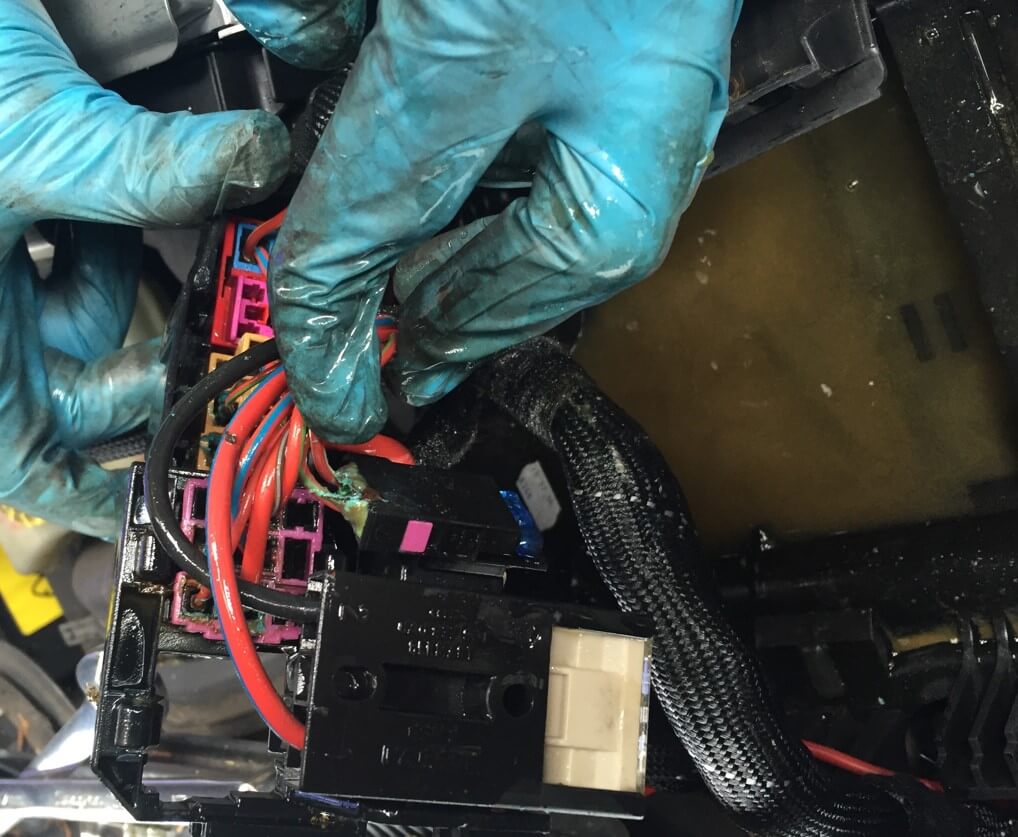It’s been raining heavily, and the car’s electronics are playing up. So as anyone would do, you pop open the hood to check for a blown fuse, and there it is – water in the car’s fuse box; sound familiar?
The two most common reasons for water entering the fuse box are a leak in a weatherproof seal or blocked sunroof(if your car has one) draining tubes. All of this and how to fix it safely without causing electrical damage to the car is explained in this article.
The function of a cars fuse box
A fuse box acts as the nerve center for all the electrical functions in your vehicle. It contains small fuses and relays that blow out to avoid any damage to the vehicle’s electrical system.
Think of the fuse box as a traffic control center. Each fuse is assigned to look after a different part of the city (your car). When there’s too much traffic (electricity) on the road (an electrical circuit), the fuse will intervene to stop the traffic(blowing), preventing any accidents (damage to your car’s electrical systems).
Most cars have two main fuse boxes, but several smaller ones may be found in various places in modern vehicles. The main one is usually found under the hood, near the engine. It controls the major external components of the car, like the headlights, engine controls, etc.
The secondary fuse box often lies beneath the dashboard or in the glove box. This fuse panel controls the secondary interior appliances, such as the interior lights, seatbelt alarm, the radio, dashboard lights, and electric windows.
Why is there water in the car fuse box?
Finding water in your car’s fuse box can be scary. They teach kids from a young age that electricity and water are not a good combination; you’ve probably been driving the car not knowing the dangers that could’ve happened. So you’ll need to find the right cause; here are the most common.
Windshield seal
The car’s windshield is sealed into place with a waterproof adhesive, often referred to as a seal or weatherstrip. This seal securely holds the windshield in place, absorbs vibrations, and prevents water from entering the interior, especially when it’s raining or you’re in a car wash.
Over time, this seal can degrade, become brittle, or even crack, allowing water seepage inside the car. If the fuse box is under the dashboard, this water may trickle down the wiring or through various gaps and find its way into the fuse box. It’s also possible that water could get in if the windshield was recently replaced and it wasn’t seated properly. If so, you may hear air leaking through the seal when driving or visibly seeing the water splash marks.
Leaking sunroof drain tubes
If your car has a sunroof, it is equipped with drain tubes. These tubes are designed to handle water that gets past the sunroof seals, which is normal and nothing to worry about.
Water will pass the seal when you open the sunroof after rain or if you’ve washed your car and it’s still wet. The drain tubes direct this water down specific channels that run down the pillars (the vertical structures on each corner of the vehicle), where they drain out under the car.
However, if these tubes develop a leak from cracking due to age or get clogged with dirt, the water will leak and run down the pillars, not in the drain tubes. Depending on the location of the fuse box, water can now get onto the fuse box in the engine bay or run down wires and enter the fuse box in the glove box. Usually, the water will continue running down until the car floor has a puddle.
Fuse box lid damaged or not fitted correctly
The main fuse box in the engine bay has its weather stripping to stop water from getting in. However, the lid needs to be in good condition and correctly fastened for this to become splash-proof. Often, this stripping gets damaged when trying to refit the fuse box cover, and people throw it away. This allows the lid to close properly, but water can enter the fuse box.
Another critical thing to remember is the fuse boxes are generally only splashproof and will not survive driving through deep water or pressure washing the engine, even more so if the lid is damaged.
The Damage Water Can Do in a Fuse Box
Water entering your car’s fuse box can lead to permanent electrical damage to your vehicle, which can be very expensive to put right. Some common problems it can cause are:
- Short Circuits – Water can create a pathway for electricity to join two unintended circuits together, causing a short circuit.
- Fire Risk – In the worst-case scenario, a short circuit caused by water in the fuse box could start an electrical fire, you may also experience smoke coming through the car ac vents (toxic fumes). While this is relatively rare, the risk exists if a large amount of electrical current is involved.
- Component Failure – Since the fuse box is connected to various electrical components of your car, water damage could lead to the failure of those components. This includes car headlights, radio, charging system, etc.; you get the picture. There are also no further warnings of a component failure; it could happen at any time, even when driving.

How to Get Water Out of the Wet Fuse Box?
As mentioned earlier, water in the fuse box is not a sign to be ignored. It could damage multiple other components. So, you need to act promptly and follow the proper steps:
- Disconnect the battery – Safety should always be your first concern. Disconnect the battery to prevent any electrical short circuits or further damage. Start by disconnecting the negative terminal first.
- Dry the fuse box – Use a dry towel to wipe up visible water. If the water is deep, you may need to use a small syringe or siphon to remove it.
- Use compressed air – If you have access to compressed air, it can be used to dry the fuse box, as it can help remove water from hard-to-reach places. Be careful not to use a compressor with too high pressure.
- Remove and dry fuses and relays – Carefully remove them from the fuse box, and dry them individually. It would help if you took a picture or ensure you have the diagram before removing them; you will need it to reassemble them. However, I recommend doing this one fuse at a time, following the remainder of the steps, and then refitting the fuse.
- Inspect for damage – Look for any signs of damage, such as blown fuses or signs of corrosion. Replace the damaged ones.
- Use a hair dryer: If the fuse box is still damp after using compressed air or if you don’t have access to it, use a hair dryer on the lowest heat setting to help dry it out. However, be cautious not to overheat any components.
- Use a contact cleaner – Once the fuse box is dry, consider spraying electrical contact cleaner, available at most auto parts stores, on the fuse holders. This can help remove any remaining moisture and prevent corrosion in the fuse holders.
- Reconnect everything – Carefully replace the fuses and relays once everything is clean and dry, then reconnect the battery.
Final Thoughts
Water in your car’s fuse box can be a severe issue as it is capable of causing significant damage to your vehicle’s electrical systems and rendering the car useless.
With the causes and procedures listed in the article, I hope you can fix it. But, if you need more clarification on the vehicle’s electrical systems, it is best to consult a professional.









